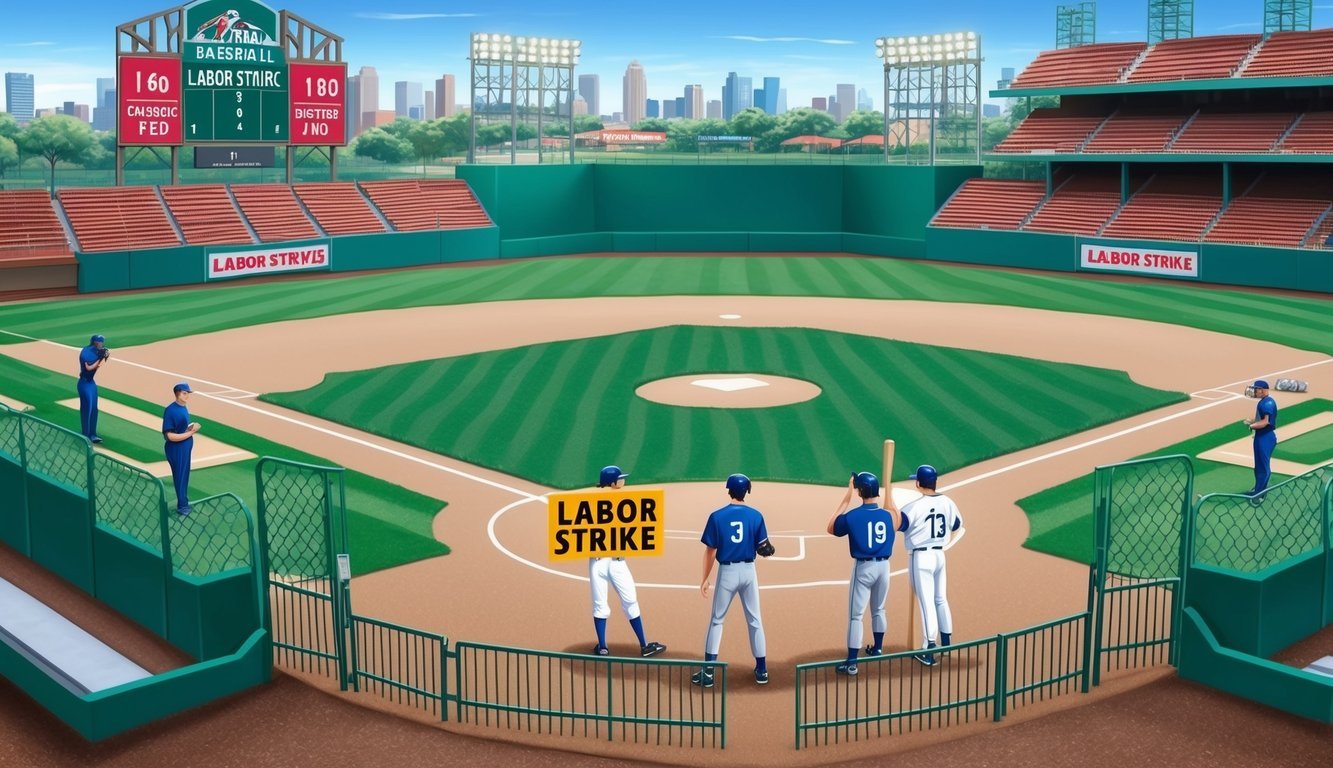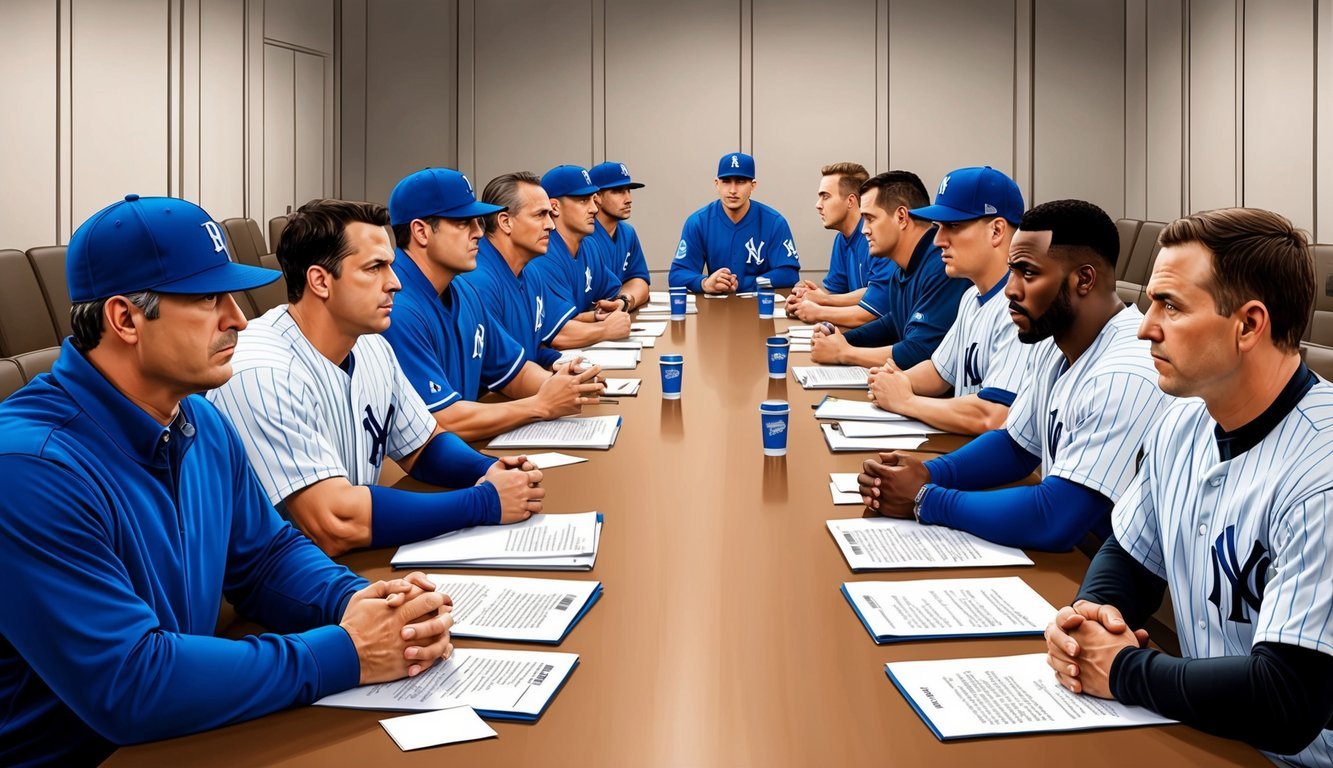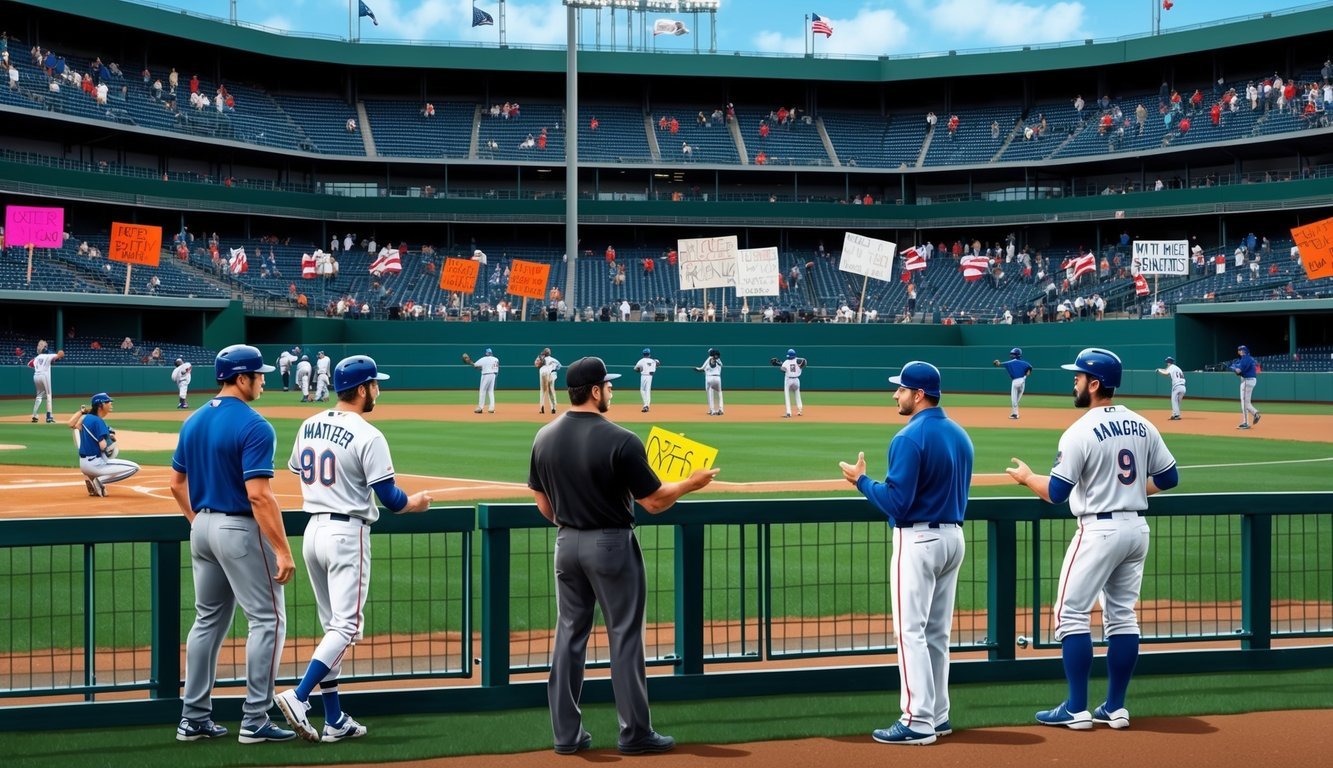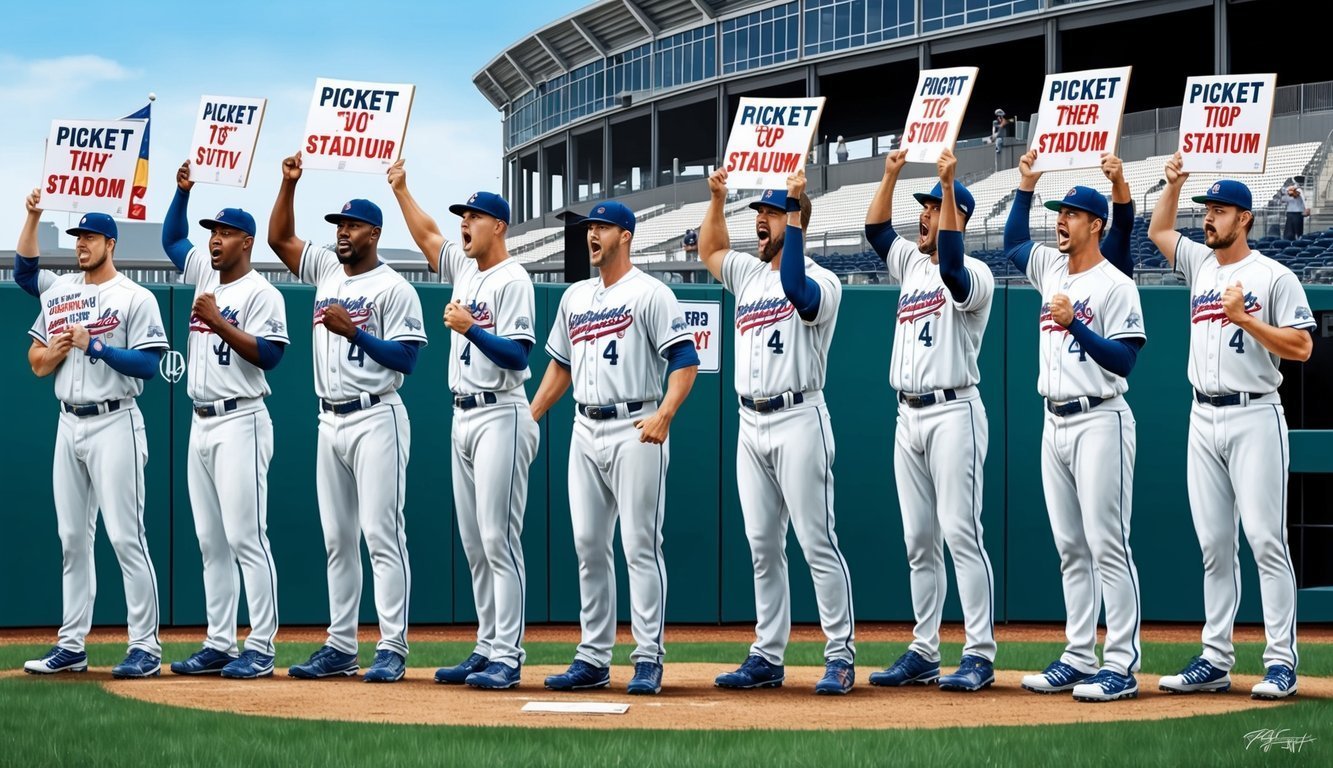Baseball’s labor history has been marked by periodic clashes between players and owners.
Since the late 1960s, Major League Baseball has experienced nine work stoppages, including strikes and lockouts.
These disputes have centered on issues like pensions, free agency, and revenue sharing.
The most recent MLB lockout began on December 2, 2021, when team owners unanimously voted to halt operations after the expiration of the previous collective bargaining agreement. This work stoppage lasted 99 days, ending just in time to preserve a full 162-game season in 2022.
It highlighted ongoing tensions between players seeking better compensation and working conditions, and owners focused on maintaining profitability.
Labor disputes have shaped modern baseball, influencing everything from player salaries to the structure of the season.
While often contentious, these negotiations have also led to significant improvements in the sport, balancing the interests of players, owners, and fans.
Understanding this history provides valuable context for the current state of America’s pastime.
The History of Labor Relations in Baseball

Baseball’s labor relations have evolved significantly over the decades.
Players gained more rights and bargaining power, while owners sought to maintain control over the sport’s economics.
The Evolution of Collective Bargaining
In 1968, Marvin Miller became the head of the MLB Players Association.
This marked a turning point for players’ rights.
Miller negotiated the first collective bargaining agreement in 1968, establishing minimum salaries and grievance procedures.
Free agency emerged in 1975, giving players more control over their careers.
This shift dramatically increased salaries and player mobility.
The reserve clause, which had bound players to teams indefinitely, was abolished.
Arbitration became a key tool for resolving salary disputes.
It allowed players with 3-6 years of service time to have their salaries determined by a neutral third party.
Key Figures and Moments
Curt Flood challenged the reserve clause in 1969, paving the way for free agency.
Though he lost his case, it sparked important discussions about players’ rights.
The 1981 strike lasted 50 days and centered on free agent compensation.
Players successfully resisted owners’ attempts to restrict free agency.
The 1994-95 strike was the longest in MLB history, lasting 232 days.
It led to the cancellation of the 1994 World Series.
The dispute focused on salary caps and revenue sharing.
Bud Selig, as commissioner, played a crucial role in labor negotiations.
He oversaw the implementation of interleague play and the wild card system.
Economic Structure and Player Compensation
Baseball’s economic landscape is shaped by complex salary dynamics, revenue sharing systems, and mechanisms like luxury taxes.
These elements work together to influence player earnings and team spending strategies.
Salary Dynamics and Free Agency
Free agency revolutionized player compensation in baseball.
Players with six years of MLB service time can negotiate contracts with any team, often leading to lucrative deals.
Star players frequently sign multi-year contracts worth hundreds of millions of dollars.
Younger players typically earn less, starting near the league minimum salary.
As they gain experience, they become eligible for salary arbitration, where their pay can increase significantly based on performance.
Some teams offer long-term extensions to promising young players, buying out arbitration years and potentially early free agency years.
This approach can provide financial security for players and cost certainty for teams.
The Role of Revenue Sharing
MLB’s revenue-sharing system aims to improve competitive balance by redistributing income from high-revenue to low-revenue teams.
All clubs contribute a percentage of their local revenues to a central fund.
This money is then distributed equally among all 30 teams.
Additional funds may be allocated to teams in smaller markets or those facing financial challenges.
Revenue sharing helps smaller-market teams compete for free agents and retain homegrown talent.
However, critics argue it can reduce incentives for teams to maximize their local revenue streams.
Luxury Tax and Salary Cap
MLB doesn’t have a hard salary cap, but it uses a competitive balance tax (CBT) system, often called a “luxury tax.” Teams exceeding a set payroll threshold pay a tax on the overage.
The tax rate increases for teams that exceed the threshold in consecutive years.
Repeat offenders also face additional penalties, such as draft pick repositioning.
This system aims to curb excessive spending by high-revenue clubs without imposing strict limits.
It encourages teams to be strategic about their payroll management while still allowing flexibility for big-market teams to spend more if they choose.
Some argue for a stricter salary cap to further level the playing field, while others believe the current system strikes a fair balance between competition and market forces.
The Impact of Labor Unrest
Labor disputes in baseball have far-reaching consequences.
They affect the game’s schedule, financial aspects, and relationships between players, owners, and fans.
Effects on the Season and Major Events
Work stoppages can disrupt the baseball calendar.
The 1994-95 strike led to the cancellation of the World Series for the first time in 90 years.
More recently, the 2021-22 lockout delayed spring training and pushed back Opening Day.
These interruptions often result in shortened seasons.
Regular season games may be canceled or rescheduled, affecting team standings and player statistics.
Postseason plans can change too.
Playoff formats might be adjusted to fit a compressed timeline.
This impacts teams’ chances of reaching the World Series.
Repercussions for Fans and the Industry
Fans feel the effects of labor unrest keenly.
Game cancellations mean disappointed ticket holders and altered travel plans.
TV viewers miss out on their favorite pastime.
The baseball industry takes a financial hit during work stoppages.
Teams lose ticket and concession revenue.
TV networks scramble to fill programming gaps.
Player-fan relationships can suffer.
Some fans view labor disputes as millionaires arguing with billionaires.
This perception can lead to decreased attendance when play resumes.
Local businesses near ballparks also struggle during stoppages.
Restaurants, bars, and shops lose customers on game days.
Negotiations and Legal Aspects

Labor disputes in baseball involve complex negotiations and legal considerations.
The process requires careful navigation of collective bargaining agreements and federal labor laws.
Collective Bargaining Processes
Collective bargaining in baseball is a delicate dance between team owners and players.
The MLB Players Association represents athletes in negotiations with team owners.
Both sides exchange proposals on issues like salaries, free agency rules, and playing conditions.
Negotiations can be tense.
In 2021, talks stalled as the collective bargaining agreement neared expiration.
Owners implemented a lockout when a deal wasn’t reached.
This halted all team activities and threatened the upcoming season.
Mediators sometimes step in to help resolve disputes.
A federal mediator may join talks to facilitate compromise between owners and players.
Their goal is to find middle ground and avoid work stoppages that disappoint fans.
Legal Interventions and Federal Law
Baseball’s unique legal status shapes labor negotiations.
In 1922, the Supreme Court granted MLB an antitrust exemption.
This ruling still influences how federal labor law applies to the sport today.
The National Labor Relations Act governs MLB’s labor relations.
It outlines rules for good-faith bargaining and defines unfair labor practices.
The law allows for strikes by players and lockouts by owners as negotiating tactics.
Additionally, the National Labor Relations Act aims to create a fair environment for both players and owners, ensuring that each party has a voice during negotiations.
In recent discussions, there has been a growing interest in innovative proposals, such as the adjustable strike zone by player height, which could fundamentally change how the game is played.
Such ideas highlight the evolving nature of labor discussions in Major League Baseball, as both sides seek to enhance the sport while balancing the interests of the athletes and the teams.
Courts generally stay out of baseball’s labor disputes.
They view work stoppages as part of the bargaining process.
Judges rarely intervene unless one side violates labor laws or the current CBA.
MLB’s legal framework aims to balance player rights with league stability.
It provides a structure for resolving conflicts through negotiation rather than litigation.
Looking to the Future

Baseball’s labor landscape continues to evolve.
Recent developments point toward potential changes in how players and owners negotiate, as well as innovations that could reshape the game itself.
Prospects for Labor Peace
The 2021 offseason lockout highlighted the need for improved relations between players and owners.
MLB commissioner Rob Manfred and MLBPA executive director Tony Clark have expressed a desire to avoid future work stoppages.
Both sides recognize the importance of maintaining fan interest and growing the sport.
New agreements may focus on addressing player concerns about competitive balance and free agency.
Teams and players could explore creative solutions like revenue sharing adjustments or changes to service time rules.
Increased transparency in negotiations may help build trust between parties.
Innovations in the Sport
Baseball is embracing change to appeal to new audiences.
The universal designated hitter, implemented in 2022, altered National League strategy.
Other potential innovations include:
- Pitch clocks to speed up gameplay
- Expanded playoffs to increase excitement
- Automated ball-strike systems for consistency
- Restrictions on defensive shifts
These changes aim to make baseball more dynamic and fan-friendly.
Players and owners will need to find common ground on how to implement new ideas while preserving the sport’s traditions.
Technology could play a bigger role in player development and injury prevention.
Advanced analytics and wearable devices may help teams optimize performance and keep players healthy throughout long seasons.
